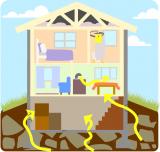Radon in Homes, Schools and Buildings
Radiation Facts
- Nearly one in 15 homes in the United States has a radon level that should be reduced.
- Radon is the second leading cause of lung cancer. Smoking is the first.
Radon is a natural, radioactive gas that you can't see or smell. Prolonged exposure to radon is known to cause lung cancer. Elevated levels of radon have been found in every state.
- Test your home, school and business. Testing for radon is simple and inexpensive. Radon levels are often highest in the lowest part of a home or building, so testing in the basement or first floor is a good place to start.
- Fix your home if a test shows elevated radon levels at or above 4 pCi/L. Find a certified contractor, get cost estimates and fix spaces with an elevated radon level. If elevated radon levels are found in your school or business talk to your school administrator or building manager about getting the problem fixed.
About Radon in Homes, Schools and Buildings
Radon comes from the natural decay of uranium and radium found in nearly all rocks and soils. Radon moves up from the ground and into buildings through the openings that exist in floors or walls (see figure below). In some parts of the country where groundwater is the primary source for drinking water radon can enter with the home’s water. Because radon comes from rocks and soils, radon typically collects in rooms that are in contact with the ground, like basements. The EPA and the Surgeon General recommend testing all homes and schools for radon. Test your home or school again if there are major remodeling or changes to the HVAC system.
Any home, school or building can have high-levels of radon, including new and old homes, well-sealed and drafty homes, and homes with or without basements. Radon also dissolves easily in water. You can learn more about radium and radon in water on the EPA’s Radon in Drinking Water webpage.
With prolonged exposure, radon may pose a health hazard. In fact, radon is the second leading cause of lung cancer in the United States. Approximately 21,000 Americans die each year from radon-related lung cancer. Only smoking causes more lung cancer deaths. The amount of radon in the air is measured in picocuries per liter of air, or pCi/L. The EPA recommends fixing homes and schools with radon levels at 4 pCi/L to reduce exposure.
What You Can Do
- Test your home for radon. Testing your home is the only way to know if you have elevated radon levels. There are many kinds of low-cost radon test kits available. You can find these kits online and in many home improvement stores. Testing is quick and easy. Short term testing only takes a few minutes to set up and testing results are available in a few days. If you prefer, you can also hire a certified professional to do the testing.
- Fix your home if your levels are high. The U.S. Environmental Protection Agency and U.S. Surgeon General recommend that homeowners take action to reduce radon levels that are measured to be 4 pCi/L or higher. If your home is found to have elevated levels of radon, hire a professional who is trained to fix (mitigate) radon problems. A qualified contractor can study the radon problem in your home and help you pick the right radon reduction system to reduce exposure. Examples include special fans and venting that help to circulate accumulated radon gas outside the home. Some radon reduction systems can reduce radon levels by up to 99%. Even buildings with very high-levels of radon can be reduced to acceptable levels, below 4 pCi/L, with proper reduction systems. Your home should be tested again after it is fixed to be sure that radon levels have been reduced.
- Ask if your school has been tested for radon. If your school has not been tested, certified professional testing services or school personnel can test your school for radon. Contact your state’s radon program before doing any school testing as some states have restrictions on who may conduct the tests.
- Advocate for your community. Indoor air quality is an important aspect of a safe learning environment. If a new school is being built or one is being updated, ask your school board to consider making it radon-resistant.


